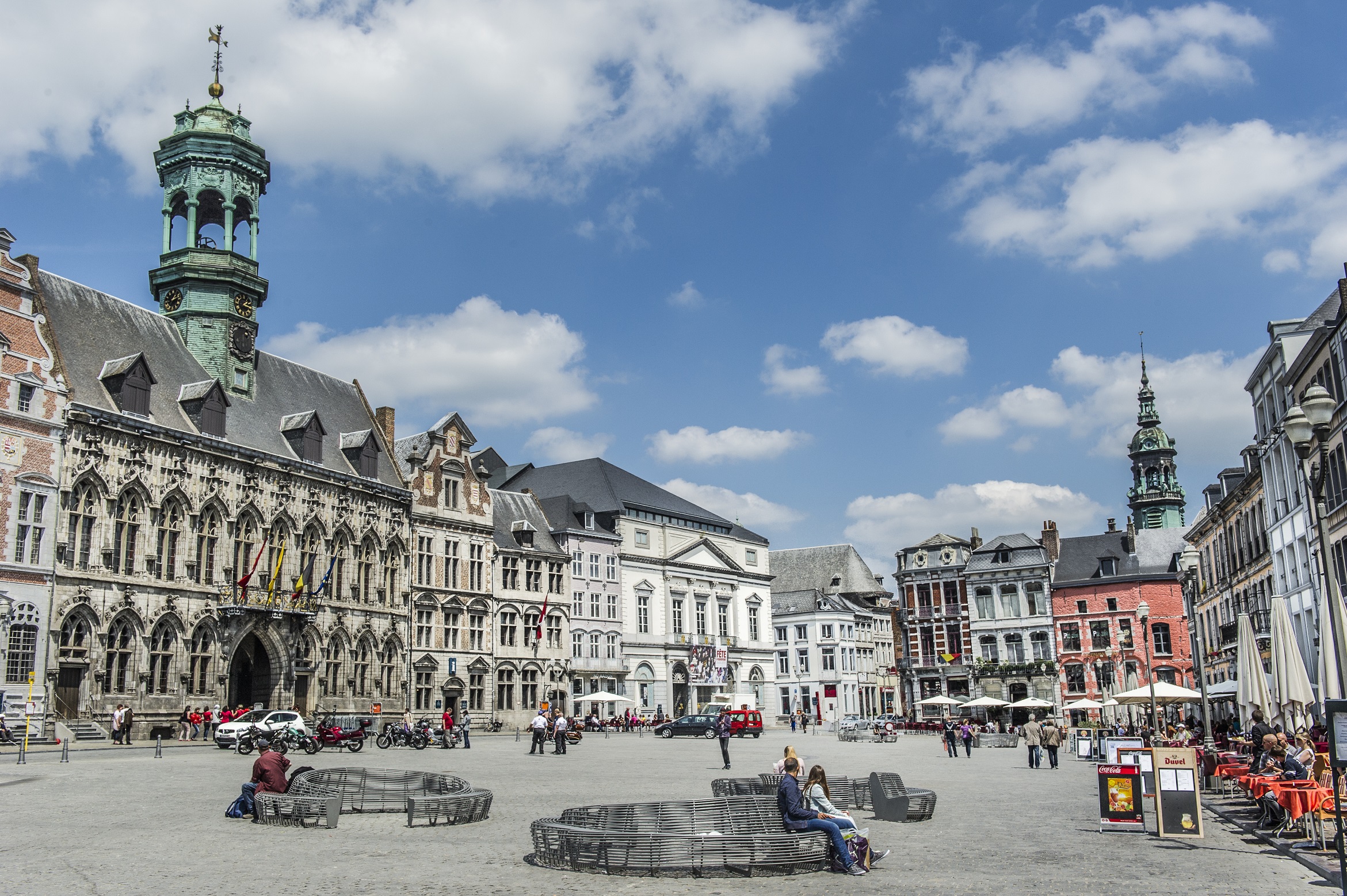Derived from the Latin word ‘montes’, for mountains, Mons in the heart of Wallonia owes its name to its hilly terrain – fitting for the capital of Belgium’s province of Hainaut, which was the European Capital of Culture in 2015.
With a population of 97,000, Mons is the ninth biggest city in Belgium. Its first famous citizen was a woman named Waltrude, who created an oratory on a hill in the 7th century around which the city was built. In turn, she became its patron saint and the oratory transformed into a monastery and then the Collegiate Church of Saint Waltrude.
Throughout its history, Mons has been a strategic military hub, attracting Romans, Gauls and Franks. For example, Julius Caesar set up a military camp on a hill in Mons during the Gallic Wars. Most recently, the Mons area was a battleground in both World Wars. Memorials, heritage and culture have helped heal the scars. It was also once a mining town, but in recent decades has moved to attract tech investment, with Google building a major data centre nearby.
UNESCO heritage
The province of Hainaut boasts the most UNESCO-listed sites and events in Belgium (20 of 37). Half are in or near Mons:
The 17th century Belfry of Mons is the only baroque belfry recognised by UNESCO. It stands 87 metres high on the highest part of the city and visitors can climb to the top for panoramic views. Victor Hugo, who visited Mons, described the belfry as “a huge coffeepot flanked by four smaller teapots.” Nice views are also from the elevated Parc du Château adjacent to the belfry where a count’s castle used to be and Saint Calixte’s Chapel from 1051 remains. There are often temporary exhibitions in the park, which is a perfect place to listen to carillon bell concerts. The latter are on Sundays 2.30pm to 3.30pm May to September and once a month the rest of the year except January and February. Carillon culture, the art of making music with bells, is also now a UNESCO Intangible Cultural Heritage.
The Ducasse de Mons, otherwise known as the Doudou festival, is similarly recognised by UNESCO and dates back to the 15th century. A ceremony on the main square, it involves a man representing Saint George killing a green dragon called Doudou with a single pistol shot. The festival starts on the Saturday evening before Trinity Sunday and has four main elements: descent of the shrine of relics of Saint Waltrude; procession of the relics on a 1781 painted wooden chariot called the Golden Coach (Car d’Or); ascent of the Golden Coach back up a steep path near the Church of Saint Waltrude (legend has it that if the chariot cannot be pushed back up, the city will have bad luck for a year); and the so-called Lumeçon battle in the Grand Place where Saint George slays a 10-metre-long Dragon (Ducasse) of Mons made of wicker and glued canvas. The Doudou Museum makes sense of it all.
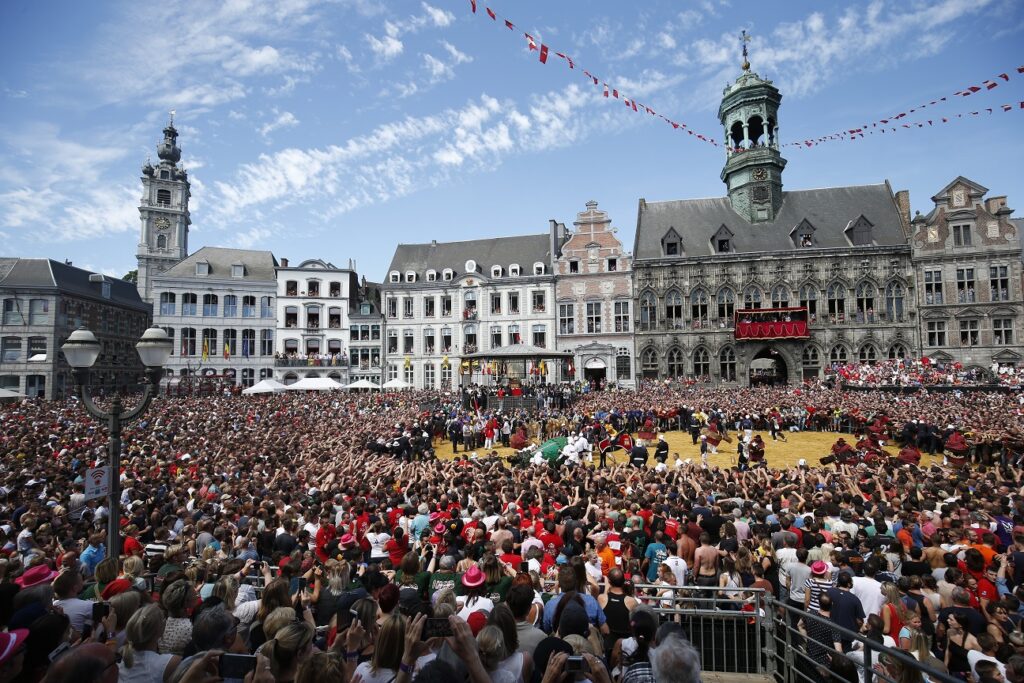
The Doudou feast compromises two parts, a procession with the shrine of Waltrude and the fight between Saint George and the dragon.
The Universal Bibliographic Repertory in the Mundaneum is on UNESCO’s Memory of the World Register as it contains 18 million bibliographic files and publication archives nearly 6km long [see separate article in this issue].
The Grand Hornu Site in Boussu 14km from Mons is a former 19th century coal mine partially turned into an arts centre. Considered a “jewel of the Industrial Revolution,” it was the birthplace of several innovations such as Belgium’s first horse-drawn railway. Today this sprawling neoclassical building includes the Museum of Contemporary Arts (MACs), Centre for Innovation and Design (CID), and the Rizom restaurant (which sources vegetables from its own garden and local, seasonal products).
The Carnival of Binche in the village of the same name 18km from Mons features three days of revelry and traditions of unknown origin. A range of costumed characters, notably some 1,000 gilles with ostrich-feathered hats and wax masks, march, dance and parade through the village. On Shrove Tuesday, they throw oranges at onlookers by day, culminating with bonfires and fireworks at night. This UNESCO Intangible Cultural Heritage is a once-in-a-lifetime experience. The Renaissance-style Binche belfry in the city hall is also recognized by UNESCO and dates to the 14th century.
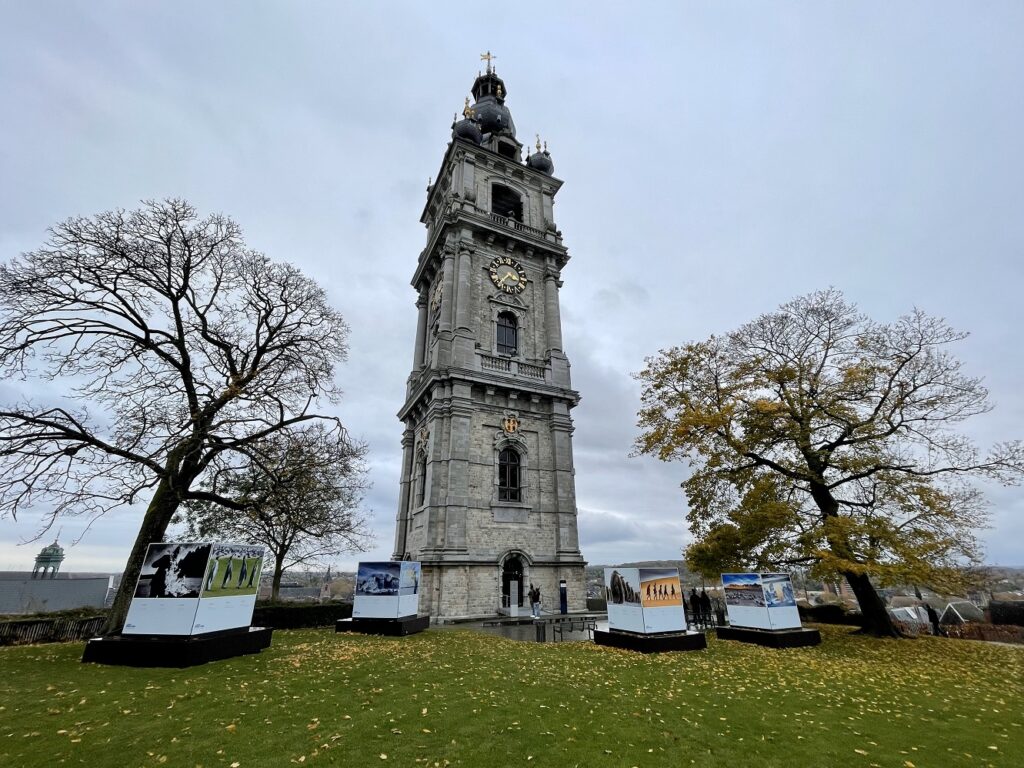
The Binche belfry
The Neolithic Mines of Spiennes include an archaeological site of one of Europe’s oldest (6,000 years) and largest (100 hectares) flint quarries and SILEX’s interpretation centre. The site has thousands of mine shafts, one of which can be visited via Visit Mons. There are also outdoor walking and biking routes and a semi-permanent exhibition. Mineshafts or bores in the area inspired the name Borinage for Belgium’s mining region. Mons is in its eastern part.
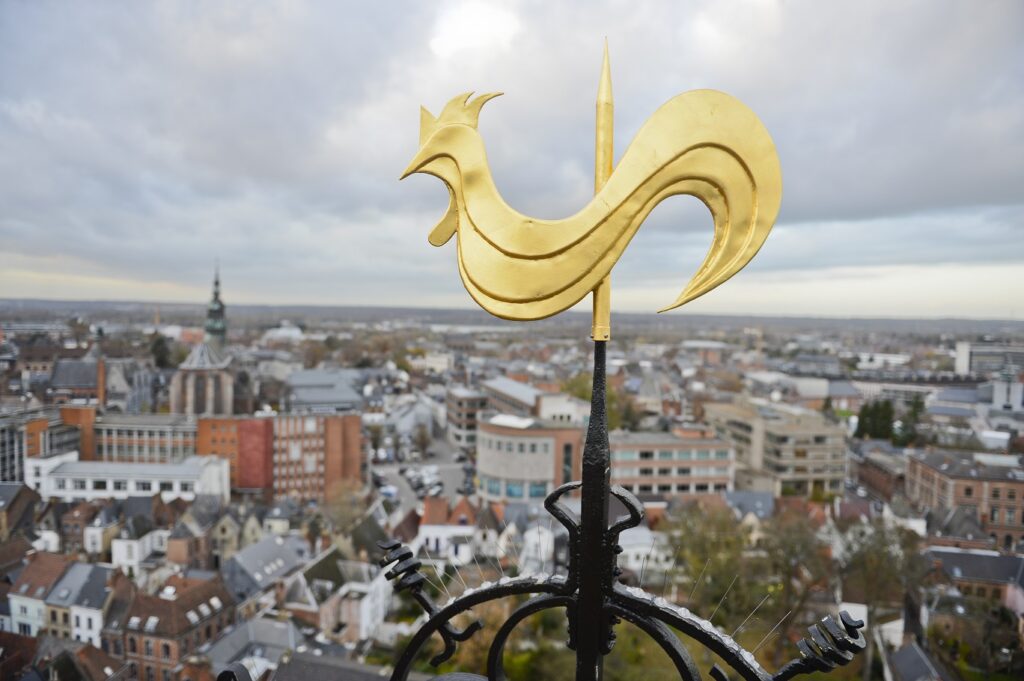
The Walloon cockerel
Four UNESCO-recognised hydraulic boat lifts are located about 20 kilometres from Mons near La Louvière on the Canal du Centre. These lifts are the only ones in the world that can function with their original mechanism and machinery. Adding just a few centimetres of water to an upper tank causes a pendulum movement that lifts boats nearly four locks in elevation. Guided cruises along the historic canal, including crossing a hydraulic lift and seeing a machine room, depart from Strépy-Thieu and can be booked via Visit Mons. The latter is Europe’s largest boat lift.
Belgian beer culture is UNESCO Intangible Cultural Heritage and Hainaut province has 40 breweries, including several in or near Mons.
The Saint-Symphorien War Cemetery six kilometres from Mons was added to UNESCO’s World Heritage list in 2023 under funerary and memory sites of First World War (Western Front). Soldiers from both sides rest there, most notably the first and last British soldiers who died in the war and the very last soldier, Canadian George Lawrence Price, to fall – two minutes before the armistice went into effect.
Military memorials
Mons holds a significant place in military history as a strategic railway and communication centre in both World Wars, but it is best known for the Battle of Mons during World War I. On August 23, 1914, British and German forces clashed in the first major engagement between the Allies and Central Powers. The British were practically encircled by the Germans, threatening their retreat. Legend has it that around midnight, angels descended from the sky in the shape of archers and stopped the Germans, enabling the British to safely get away. “The Angels of Mons” legend became famous by Welsh author Arthur Machen and Montois painter Marcel Gillis. A street art depiction of it is now in Mons at Chemin des Mourdreux 2.
The Mons Memorial Museum retraces the city’s military history from the Middle Ages to the 20th century via multimedia displays and 5,000 objects. It focuses on the World Wars with witness accounts from soldiers and civilians. The museum also has temporary exhibitions, such as the current ‘Wool and Water’ with paintings by Montoise artist Didier Mahieu until April 14, 2024. (The water theme relates to the museum building once housing the Mons Water Machine, which supplied the city’s drinking water.) From July 6, 2024, to spring 2025, an exhibition called The Angels of Mons will commemorate the Battle of Mons and its spiritual legend.
New as of September 2023 is a Tunnel of Peace in the Croix-Rouge Tunnel that was painted into a war memorial by fine art students under the direction of Belgian muralist Piet Rodriguez. It includes facts and a 1915 poem by Canadian soldier John McCrae, author of “In Flanders Fields.” The tunnel is located at the intersection of Blvd. Winston Churchill and Rue de la Croix Rouge.
A monument in Place du Parc honours the Montois and allied soldiers who died in the World Wars. A nearby tree was planted to commemorate the 1914 Battle of Mons (a sister tree is in Sydney, Australia).
Architecture
Beautiful buildings covering centuries are concentrated in the Grand Place. Most notable is the gothic city hall topped with a baroque bell tower, built in the 15th century by the same architect as Leuven’s city hall (Mathieu de Layens). It is surrounded by baroque guild houses from the 17th century and the ornate Royal Theatre of Mons from the 19th century. A monkey of the ‘Grand Garde’, a forged iron statuette, sits on the city hall’s façade, challenging the Dragon of Mons as the city symbol. Legend has it that anyone who strokes the monkey’s head with his or her left hand will have a year of good luck. The Jardin du Mayeur behind city hall, accessible via a vaulted passageway, and interior period rooms are also worth a look.
The gothic Collegiate Church of Saint Waltrude is a masterpiece of medieval architecture. Construction began in 1450 but it was only completed in 1691. It has 29 chapels, an organ with 4,500 pipes, stained glass windows by a Montois master, an impressive art collection and treasury, reliquaries (bones and skull separately) of Saint Waltrude, and the Golden Carriage used in the annual Doudou festival. Notable artworks in the church are alabaster statues of Saint Barthelemy and the seven cardinal virtues by Jacques Du Broeucq and a white stone sculpture of Saint Michael stabbing Satan (rarely depicted in churches). Organ concerts are every Sunday in July at 6 pm.

The Collegiate Church of Saint Waltrude
The Spanish House was one of several Spanish-style buildings established in Mons after a great fire in 1548. At the foot of the belfry, it is a repository of information about all UNESCO sites and events in Hainaut province as well as the new belfry ticketing office.
Maison Losseau is a beautiful Art Nouveau house designed by Belgian architect Paul Saintenoy, who also created the Musical Instruments Museum in Brussels. Mons lawyer Léon Losseau commissioned him and various craftsmen to create his ideal home at the turn of the 20th century in a 17th century townhouse. Now a Wallonia heritage building, Maison Losseau has an exquisite interior dominated by a large stained-glass skylight. It was also the first house in Mons to have electricity and an elevator. Maison Losseau has a tree-lined garden behind it and connected interpretation and Hainaut literature centres plus temporary exhibition space. Adjacent to it is the stately Mons courthouse (Tribunal de première instance).
As an architectural contrast, the Gare de Mons (train station) looks like a spaceship with legs. It was designed by Spanish architect Santiago Calatrava, like the one in nearby Liège, but is still not completed, is already nine years overdue and 10 times over-budget.
Art and culture
The Beaux-Arts Mons (BAM) near the Grand Place has three museums in one building: the Museum of Fine Arts, Museum of Decorative Arts and Museum of Contemporary Arts. It boasts more than 15,000 works and hosts annual exhibitions around an artist, movement or theme. It is currently closed for renovation until April 2024, when it will reopen with an exhibit about French sculptor Auguste Rodin. It will show 200 of his works from Musée Rodin in Paris and private collections, including sculptures, drawings, engravings and paintings.
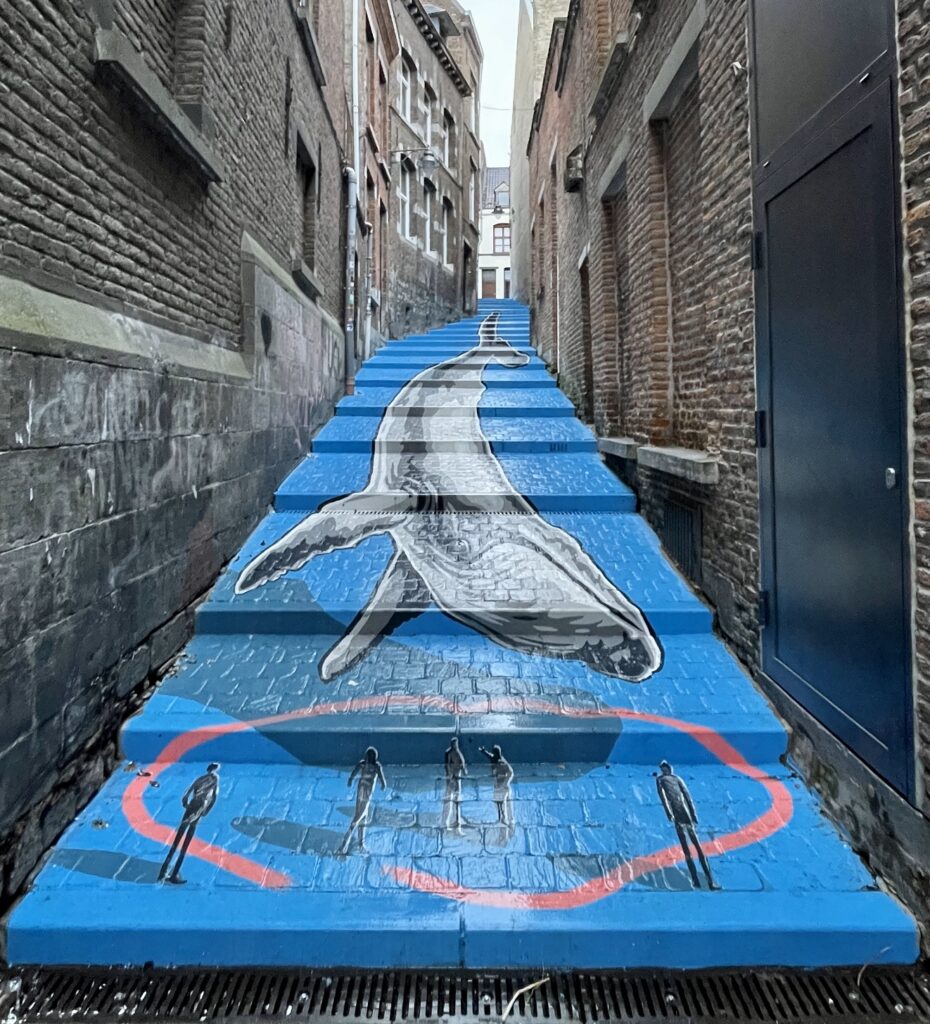
Street art
The Artothèque in an 18th century chapel houses 50,000 works of art related to Mons heritage. Most are in storage because this unusual museum is a conservation site for archiving, researching, restoring and studying art. A high-tech exhibition room and art library are accessible daily and guided tours to storage rooms the last Sunday of each month. State-of-the-art interactive touch and motion screens enable visitors to see and learn about displayed and archived artworks. Displayed items change several times per year.
The François Duesberg Museum in the former buildings of the National Bank of Belgium has an international reputation for its neoclassical collection of clocks (1775-1825), porcelain, gold and bronze objects, and antique jewellery. Its clock collection is one of the largest in the world. Roughly 4,000 objects were acquired by Baron Duesberg, who manages his namesake museum, and his late wife, who is buried in the property’s courtyard. Nearby the museum outside is a giant, silver, modern sculpture called La petite fille aux papillons (The Little Girl with Butterflies).
The Anciens Abattoirs (Old Slaughterhouse) hosts events and temporary exhibitions by Belgian artists focused on applied arts.
Mons is included in the app Street Art Cities with a map of nearly 100 murals on building façades and other works by European artists. Rue des Fripiers in the historic centre has coloured cobblestones and illustrations, including the Dragon of Mons. Locals repaint the cobblestones yearly.
Maison Van Gogh in Cuesmes about 3km from Mons was where the Dutch painter lived for nearly two years (1878-80) when he was a preacher to coal miners and began his artistic career. Learn about his life in his mid-20s, what he read and wrote, and artworks he made during that time. Visit Mons sells a Van Gogh Borinage Pass (€8) for access to his former workplace, homes and Artothèque.
Victor Hugo was also in the Borinage, visiting Mons as his first Belgian city. In 2002, Mons named a public passageway after him: Passage Victor Hugo through Hôtel de Graty near the belfry.
Local specialties
Domaine du Chant d’Éole in Quévy-le Grand 18km from Mons is arguably Belgium’s best sparkling winemaker – and its bottles of bubby are hard to find in Brussels. But you can buy them at the winery, including magnums, every day but Sunday. Domaine Mont des Anges in Spiennes also makes notable wines.
The Mons area is home to several microbreweries, including Brasserie Saint-Lazare, La Douffe, Brasserie La Montoise, Brasserie 113, Le Brasse-Temps right in city. Tours of the historical centre of Mons combined with either a brewery visit, brewing workshop or zythology (study of beer and beer-brewing) can be booked via Visit Mons. Vhello bike tours from 20km to 36km to various breweries are also available.
Mons greeters are free volunteer tour guides who can be booked via visitmons.co.uk/greeters or 065.33.55.80. Visit Mons also offers official guided tours by themes in various languages. It sells the Mons Card for access to all tourist sights and bicycle rental for 24 or 48 hours, respectively, for €18 or €25. (Note the first Sunday of each month, municipal museums are free.)
Located about halfway between Brussels and Lille, Mons is just a 45-minute train ride from the European capital and well worth the trip.
Experience Mons
Love International Film Festival Mons: Offers screenings and discussions of works by emerging filmmakers from around the world, March 8-16, 2024, liff-mons.be
Battle of Lumençon: Annual fight of St. Georges against a “dragon” during the Doudou festival, June 2, 2024, visitmons.co.uk
Festifood RTL Mons: Gastronomy festival featuring dishes by local Michelin-starred restaurants at affordable prices, early September, festifoodrtl.be
Festival au Carré: Ten days of performing arts throughout Mons starting in in late June, surmars.be
Mons Coeur en Neige: A Christmas “village of artisans” in the Grand Place and an ice skating rink on Marché aux Herbes each December, monscoeurenneige.be
Mons en Lumières: New in 2024 as the first light festival in Wallonia, it features three kilometres of art and 25 light installations in Mons' historic centre, late January-early February
Carnival of Binche: See the masked dancers with ostrich-feathered hats in the three days before Lent in the nearby village of Binche, February 11-13, 2024
SAVOUR
La Table du Boucher: Upscale restaurant featuring Belgian specialities and grilled meats. An Italian restaurant by the same chef is Le Comptoir de Marie.
L’Envers: Offering continental gourmet cuisine à la carte or by menu with an extensive wine list, plus a nice terrace.
Le Faitout: In Baudour outside of Mons, a large brasserie with excellent Belgian food and a terrace.
Les Gribaumonts: Offering “inventive, daring and passionate cuisine” in an 18th century building with wine pairings by an on-site cellar master.
Masu: Featuring modern, creative cuisine that’s a fusion of Asian and European influences.
SIP AND SNACK
La Cervoise: In the Grand Place, a cosy place to taste local beers and cook meat on a hot stone at your table.
Le Modjo: Bar in the historic centre featuring artisan cocktails.
MoMA: Cozy café frequented by locals with outdoor seating.
Texas Coffee House: Café with supposedly the best coffee in the city as well as savoury and sweet waffles and baked goods.
Vis à Vis: A “tasting bar” for wine and food that’s a favourite among locals.
STAY
Martin’s Dream Hotel: A four-star hotel partly built in a neo-gothic, 19th century chapel. Stay includes a sumptuous breakfast and optional spa.
Hotel Lido Mons Centre: Stylish, four-star hotel in Mons’ historic centre.
Apart Hotel Sainte-Georges: Steps from the Grand Place, it offers studios, apartments or a duplex with equipped kitchens for two to five people plus a garden.
Hotel Saint-James: A charming three-star hotel in a renovated 18th-century building that’s good value for money.
Van der Valk Hotel Mons Congres & Spa: For those who prefer large hotels, this one has a pool, fitness centre, restaurants and a bar.
SHOP
Créa’City: Boutique with unique items made by European artists.
La Vie Moderne: Interior design shop with unique jewellery, home accessories and furniture.
Les Sentiers de Charlye: A “depot for artists and artisans” that sells paintings and objects made by locals.
Mons où Venir: Gift shop focused on regional folklore.
Grand Hornu: Shop at the former coal mine in Boussu selling a range of smart designs and artsy items.

